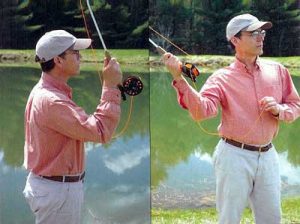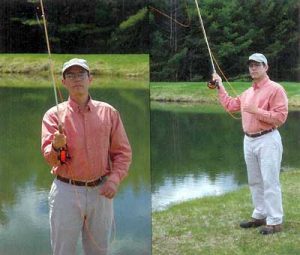Casting: The Elements of Style
IF YOU ARE LIKE most fly rodders you are stuck in your own casting style. It’s probably holding you back from a more comfortable, accurate, or graceful cast. Even if you’re new to fly fishing, you may already be an old-dog caster, a captive of a hard-wired casting style, but this article will help you break free. If you’ve ever gotten a sore arm or shoulder from casting during a long day of fishing, please read on. If you’ve ever been frustrated because you couldn’t land the fly where you wanted, read on. If you’ve ever wondered why some people make casting look so easy, read on. Let’s throw off your old-dog style and learn a new way to cast.
While there is no universally wrong or right casting style, there is an optimal style for you. This is the one that lets you make the best cast at a given distance with the greatest ease. Because of differences in musculature, joint configuration, and flexibility, what is easiest for one angler may not be easiest for another. So, while there is no correct or incorrect casting style, there are easier and harder ways for you to make the cast you want. The problem is that casters don’t always naturally gravitate to this optimal style. In fact, many unfortunately adopt a style that is ill-suited to them. I’ve coached hundreds to experiment so they a could find a better style. This article will help you get there.
Mechanical Advantages
The distance at which you are casting, the accuracy you need, and even the rod-and-line combination you are using, will have some bearing on your style. Short casts don’t require much rod travel, so you don’t need to make your hand travel very far between the backcast and forward-cast stops. In fact, some of our greatest trout anglers are very “wristy” casters when playing the short game for trout. Why? Because the all-wrist cast is mechanically simple and very accurate at short distances. But what about longer casts? The laws of physics require you to move the rod far if you want to cast far. How do you move the rod far with your wrist? You can’t. You have to use some combination of elbow bend and shoulder movement. For very long casts, you need to move your whole torso, usually by rocking back and forth or by turning at the hips with the cast.

The two basic casting styles are “front-elbow” (left) and “side-elbow” (right). Of course, many anglers fall somewhere in between these extremes, but if you learn to cast in both styles, you’ll have a good chance of improving both your distance and accuracy. Jim Rowinski photo
In this article, we’ll use a progression of style drills to help you find your own optimal style for a 40-foot cast. While most good casters have a fairly uniform style at very short distances, 40 feet is the distance at which we begin to see noticeable stylistic deviations. I encourage you to try these drills even if you are already comfortable with your casting. Many times, I’ve suggested minor style changes to my advanced students and had them exclaim, “Wow!” Whether it was more distance, fewer tailing loops, or just a cast that seemed to take less effort, my students had found a better way to cast because making good loops just got easier.
The most detailed analysis of casting styles, particularly arm styles, has been performed by Al Kyte and Gary Moran. (See “Fly Casting: Substance & Style,” by Al Kyte and Gary Moran, in the March/April 2000 issue of American Angler.) They identified three major arm styles among elite-level casters, but we’ll consolidate these into two. One keeps the elbow in front of the caster during the backcast. We’ll call this front-elbow. We’ll call the other one side-elbow because it brings the elbow out to the side of the caster during the backcast. Of course, these styles do not have discrete boundaries. Many casters fall into a gray area, in which the elbow’s average position is about 45 degrees forward of the shoulder.
Before You Start
Set up a video camera and film yourself from your rod-hand side. Cast perpendicular to the camera’s direction of view, and zoom in enough so you can see your elbow position. This is worth doing because most of us have very little awareness of how and where our bodies are moving during a cast. The camera will show you if you are actually casting in the styles you’re reading about and seeing photographed here. First, film yourself making 40-foot false casts in the way you normally do them. When you replay the tape, look at your elbow position during your backcast stop. If your elbow is in front of your body, you’re a front-elbow caster. If it’s to the side or behind you, you’re a side-elbow caster.
We’ll start by working on the stance, later on arm style. After you have gone through the drills for both, you will be able to come back and better isolate changes to one or the other. For now, try to keep your arm going in the same motion through both stances. This should be fairly easy at 40 feet but becomes harder as the distance increases or if you cast an outfit heavier than a 7-weight.
Angles of Attack
We will try two different stances at 40 feet. First, make 10 false casts in your style with both feet pointing at the target. We call this a squared stance because your torso is facing squarely at the target. Now, make 10 more casts with your feet pointing about 45 degrees to the right of the target (assuming you’re right-handed). We’ll call this an angled stance. Which one feels better now? (As your casting improves, you’ll be better able to cast well regardless of how the boat position or the river bottom requires you to stand.)

Few anglers pay much attention to stance when they’re casting, but it’s an important part of the overall casting motion. In the squared stance (left), the torso is square to the target, which improves accuracy. The angled stance (right), with the feet pointing about 45 degrees to the right of the target (for right-handed casters), allows the torso to rotate during distance casting. Jim Rowinski photo
Next it’s time to try different arm styles. Arm style is so ingrained in most casters that it can be exceedingly difficult for some casters to make even temporary changes in their motion. So it’s important that you videotape yourself to be sure you’re doing what you think you’re doing.
Start with a 40-foot side-elbow cast. The main characteristic of this style is that the elbow moves horizontally throughout the casting motion. It slides back to a position either beside or behind you as your shoulder opens during the backcast. Before practicing this style, it is important that you set your feet in the angled stance you tried earlier. This position should facilitate the shoulder movement that makes this style comfortable.
When you’re false casting, it should feel as though you’re pulling your elbow back during the backcast and pushing it forward during the forward cast. To get the hang of this, it will help to pantomime some false casts with your arm. If this is the style you have been casting in already, it should seem perfectly comfortable. But if it’s not, it may feel totally alien, even alarmingly so. Unless you have a shoulder injury, stay with it. After 20 years of teaching, I’ve learned that the more a caster practices change, in any aspect of the stroke, the better he becomes. Playing with these style changes is the fastest way to tighter, more accurate loops and longer distance.
Now try front-elbow casts with the squared stance. Set your feet first, and then practice the arm style. In front-elbow casting, the elbow moves up and down instead of horizontally. It should feel as though you’re pushing your elbow up during the backcast and pulling it down during the forward cast. Pantomime it, making sure that bone in your upper arm is pointing directly at the target. Then cast and check the videotape.

When you are practicing the side-elbow cast, make sure your elbow moves horizontally throughout the casting motion, sliding back to a position either beside or behind you as your shoulder opens during the backcast (left). Then you’ll want to push your elbow forward during the forward cast (right). Most anglers use this style for distance casting. Jim Rowinski photo
In order to really learn from this process, you need to see that you are doing both arm styles as you see them pictured in the photos shown here. I recently coached a cardiologist who was comfortable with the side-elbow style, but he wanted to improve his accuracy. I suggested that he try the front-elbow style because it is, for most casters, considerably more accurate. He didn’t believe me when I told him that he was casting purely side-elbow; he just knew he was casting front-elbow. When I showed him the tape of his casting, he was stunned by the difference between what he felt and what he actually saw. Ironically, it was only after told him to try cast with his right elbow in front of his heart, a virtual impossibility, that he moved his elbow in front of him. To this day, he raves about how much he likes trout fishing in this style.
Cast Farther in Both Styles
The conventional wisdom among casting instructors is that front-elbow is better for accuracy and side-elbow for distance. But there are world-class casters who fish quite accurately using their comfortable side-elbow style. And they have peers who cast very far in a natural front-elbow style. What’s important isn’t that you conform to what some casting instructor tells you is best but that you find what you like best.

In front-elbow casting, the elbow moves up and down instead of horizontally. It should feel as though you’re pushing your elbow up during the backcast (left) and pulling it down during the forward cast (right). The front-elbow style can improve your accuracy. Jim Rowinski photo
To find the best distance style for you, try casting 50 feet. (That means the yarn on the end of your leader lands 50 feet from you.) Try it first in the style that feels the least natural to you. This will take some patience on your part. At greater distances, most people naturally gravitate to the side-elbow style. So if you’re more comfortable at the outset with that, work diligently to cast 50 feet in the front-elbow style. At the backcast stop, you’ll need to lift your elbow more, bringing your hand close to your ear. Make quite a few false casts this way. Look at the videotape to check your style. Close your eyes to really dial in the changes you make. After a lot of repetitions, ask yourself what you’ve learned.
On the other hand, if you primarily cast with your hand in front of you, the side-elbow style will be a stretch. Give it a chance; try it out through lots of repetitions. Check the videotape to see that your hand and elbow are swinging out horizontally beside or behind you when you backcast. Do lots of these, some with your eyes closed. Program it into your muscle memory.
Unless you have some kind of injury, there’s no reason you can’t use both arm styles in your fishing. Thanks to my style coaches Al Kyte, Bruce Richards, and Tim Rajeff, I’m now comfortable with both. But it took some effort. At first, my new style seemed awkward. Now, it helps me catch more fish more comfortably.











